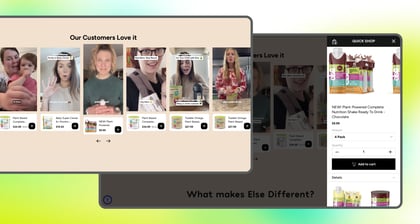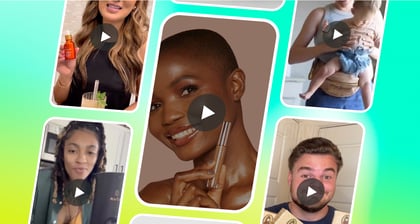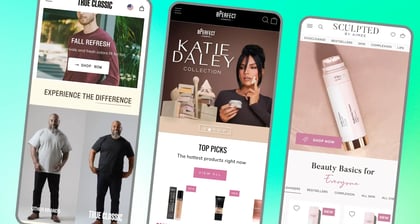Share
Consumer trends have evolved considerably in recent years, and people are digesting more video content than ever before. However, more interesting is how business owners and marketers have responded to these trends.
We're talking about video marketing. Brands have upped their video marketing budget to create more engaging, interactive experiences for customers. Ecommerce has even gone as far as introducing shoppable videos, allowing customers to shop while they watch videos about your products.
Exciting times are here, and if you're looking to invest in video marketing for your Shopify store, let's see how you can get the best results.
What is Video Marketing?
Video marketing leverages video to increase engagement and help you guide customers along their buyer's journey.
Brands use video marketing to address customers at each stage of the funnel. Educational videos help customers that have just begun their journey, and explainer videos, demos, and testimonials move customers from the consideration to conversion stages.
Video marketing can be combined with your existing marketing strategies - such as social media or email - to improve results and conversions.
Why 3rd-party Hosting Doesn’t Work For Shopify Stores
Third-party hosting platforms like Instagram, TikTok, and YouTube make it easy for you to publish video content and get in front of your target audience.
But it also makes it easy for your competitors to do the same.
That means you're left fighting for customers' attention, and if you do catch it, there's no guarantee you'll maintain it. Your competitors' content is still fighting for your audience's attention.
But hey, you can make better videos and beat your competition out. Right?
You can, but this raises another problem; how do you know that your videos are performing better? Likes and impressions only reveal so much, and third-party platforms give you limited access to vital performance data. This makes it difficult to calculate the ROI for your video marketing.
And data restrictions aren't the only limitations imposed by third-party platforms. Brands also have limited options for moderation, so unhappy customers (or your incognito competitors) can drop a few likes and negative reviews, undermining your video marketing efforts.
Social media platforms are still a great channel for engaging with your audience, but they're not the best for direct video marketing. One of the most conversion-friendly video marketing features they miss out on is making your videos' shoppable' - i.e., letting customers buy products directly from your videos.
So if your goal is to increase conversions for your Shopify store, it's best to take your video content back to your turf.
How Your Shopify Store Benefits From Video Marketing
Video marketing has evolved substantially over the past few years due to evolving consumer trends. People are consuming more video content than ever.
And here's more on how this evolving trend is helping Shopify stores.
Customers want videos
According to Hubspot's findings, more than 50% of consumers want to see more video content from their preferred brands. And more than 70% of consumers prefer to learn about your product or service from a video.
So if you're looking to generate leads and increase conversions, video is looking pretty good. But if you're going to invest in video marketing, you should:
- Use captions in your videos because most consumers view videos with the sound off (source).
- Use an informal, chatty tone for your voiceover because 75% of customers decided not to purchase after listening to a video with an 'annoying' voiceover.
- Keep your videos short because few consumers will watch long videos all the way through.
In short, consumers do want more videos, but they want the right kind of content.
Videos keep customers on your site
Social Media Week found that video-rich sites increased users' time browsing by a whopping 88%. That's nothing to overlook. And to top things off, more than 85% of marketers said video marketing helped increase their website traffic.
So yes, videos can keep customers on your site, but you need to be strategic about video placement and the type of content. For example, slapping a "company mission," storytelling video on a high-converting product page probably won't increase your conversions (it might kill them instead, come to think of it).
But a product demo on your product pages can help engage your customers. And a video that walks customers through your new collection can increase engagement on a landing page.
Videos are easy to share
Most digital content is easy to share now. But video content is very 'shareable.'
We mean that videos compile relevant information in a single, easy-to-digest format. For example, if you launch a video featuring a new collection, it's easy for your customers to share that video with their friends. Much easier than, say, sharing individual product pages.
Moreover, as a Shopify store owner, videos are more shareable for another critical reason: embeds. You can easily host your video content on a third-party platform and embed the link on your website. Embeds also make it easy for other websites to promote your videos, like product reviews and affiliate sites.
Rely less on social media for conversions
Social commerce and live shopping have gained momentum, and they're certainly viable options for increasing conversions. But the glaring problem with these options is they put you at the mercy of third-party platforms.
These platforms can maximize your organic reach, limit your access to crucial data, and make it difficult for you to moderate your company pages. These constraints are fundamental reasons why Shopify merchants are looking to reduce their reliance on social media for conversions.
And that's why owning your video content is so valuable. By taking your video marketing to your turf, you have more control over campaigns.
Easily make your videos shoppable
Why is this so important? Let's answer your question with two statistics (source):
- Shoppable videos can increase purchase intent by nine times.
- Shoppable videos have encouraged more than 40% of consumers to add products to their carts.
So, making your videos shoppable can be one of your most powerful conversion tools yet. And when you invest in video marketing, you can leverage third-party applications to create your videos shoppable and embed them directly on your website.
Shoppable videos also help you reduce your reliance on social media platforms for driving conversions. Which, as we discussed earlier, is crucial for owning your audience.
How To Use Video Marketing For Your Shopify Store
You can get the best results from video marketing by combining it with your other marketing efforts. And here's how.
Videos can help you increase consumer engagement and conversions, but you'll still need a way to get eyeballs on your content. And email is one of the most effective channels for content distribution.
Unlike most social media platforms, email doesn't limit your reach and pressure you to invest in paid advertising. So long as you maintain a healthy sender's reputation, email can help you reach your audience directly.
So if you're launching a new collection or product or have a special sale coming up, combining video marketing with email can improve your campaign's effectiveness. Including videos in your emails can increase your click-through rates by up to 300% - guaranteeing more eyeballs on your campaign.
SMS
SMS is another excellent channel for reaching your audience quickly, and it boasts the highest open rates. But text messages have far more constraints than emails do.
With SMS marketing, you're limited to 160 characters per message, including your video URL's length. You also can't embed the videos directly in your message.
So, you can either go the MMS route - and include a video inside the message - but the video will need to be very short. Around 15-30 seconds at most. MMS can thus be a great option if you have a short, punchy promotional video.
But if you're looking to complement a full-scale campaign, you might be better off using SMS to compliment your video marketing efforts. You can use a URL shortener to save your character count and enticing leverage copy from getting people to click through.
3rd party sites
If you use a 3rd party video hosting platform like VideoWise, you can make your videos Shoppable and directly embed them in your Shopify store. This option lets customers add items to their cart directly from the videos and proceed toward checkout, significantly reducing friction from their buyer's journey.
The Key KPIs For Success With Video Marketing On Shopify
If you're investing in video marketing for your Shopify store, it's essential to track your videos' performance and optimize. Here are the most important KPIs for success that you should monitor.
Conversions
Conversions depend on what you define as a conversion for your video. For some videos, a conversion might mean following a CTA to "learn more" about your product or to watch another video.
For a shoppable video, a conversion would be a purchase made by a consumer through the video's shoppable features.
Whatever your conversion is defined as, it's the most important KPI for measuring video marketing success.
Watch rate
Watch rate is a percentage of how long viewers spend watching your video. Watch rate is calculated by averaging how long each viewer spends watching your video.
So, for example, if 50 viewers watch an average of 60 seconds of your three-minute video, your watch rate is ⅓.
Added time on site
To calculate the added time on site, you need to:
- Measure the average time spent by a site visitor before video content is added
- Measure the same average time after adding video content
And then subtracting the second metric from the first. If you see an increase in time spent, your video marketing efforts are successfully engaging your visitors.
Videos watched
Videos watched are simply the number of videos that an average visitor watches when visiting your website. A high number of videos watched indicates that your video marketing strategy is successful because customers are interested enough to watch multiple videos.
How VideoWise Makes Video Marketing Easy For Shopify Stores
VideoWise helps you supercharge your Shopify stores by tailoring your video marketing for conversions.
How Axel Glade increased ROI by 272
VideoWise helped Axel Glade increase ROI by x272 by improving the performance of the brand's how-to videos.
Axel Glade developed a unique product for cleaning your ears, and since the item is very visual, the brand relies on videos to educate customers about it. The brand discovered YouTube video reviews and how-tos that received high engagement, so the brand leveraged VideoWise to collect UGC and make the videos shoppable.
The result? More engagement and more conversions.
Easily shareable links
VideoWise's shareable links make it easy to embed shoppable videos in your Shopify store and grow your video marketing.
Shoppable videos
Adding shoppable elements to your videos improves engagement and conversions, and VideoWise lets you turn any video into a shoppable one. Reduce the friction from your buyer's journey by making it easy and fun for them to make purchases.
Powerful analytics
Analytics and reporting are crucial for measuring your video marketing's success. VideoWise empowers Shopify store merchants to accurately measure video performance and ROI with its advanced analytics suite. You can track crucial success KPIs like added session time, conversion rate increases, and engagement rates.
Conclusion
Done right, video marketing can help you grow your Shopify store by creating interactive, engaging experiences for your customers. You can meet their needs at each stage of their buyer's journey and help them seamlessly transition along with it.
If you're going to invest in video marketing, it's essential to think long-term. Plan your strategy around initiatives that let you own your audience and reduce reliance on external platforms like TikTok or YouTube.
Offer customers the best experiences on your turf.
Share
.png?width=540&height=97&name=Videowise%20logo%20(1).png)



